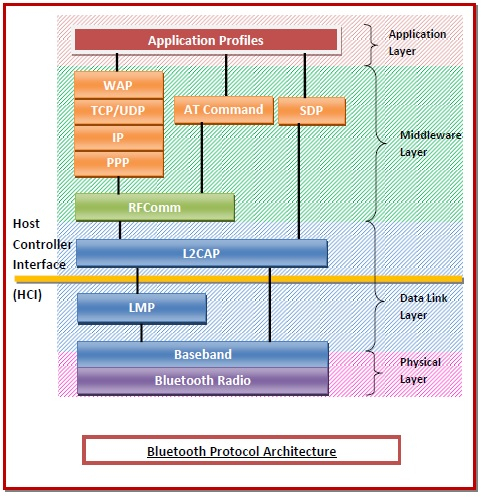The Bluetooth Protocol Architecture
https://www.tutorialspoint.com/the-bluetooth-protocol-architecture
-
13-09-2020 - |
Question
The Bluetooth Protocol Architecture
Bluetooth network technology connects mobile devices wirelessly over a short-range to form a personal area network (PAN). The Bluetooth architecture has its own independent model with a stack of protocols, instead of following the standard OSI model or TCP/IP model.
The protocols in the Bluetooth standard can be loosely grouped into the physical layer, data link layer, middleware layer, and application layer as shown in the following diagram −

Protocols in the Bluetooth Protocol Architecture
Physical Layer − This includes Bluetooth radio and Baseband (also in the data link layer.
Radio − This is a physical layer equivalent protocol that lays down the physical structure and specifications for transmission of radio waves. It defines air interface, frequency bands, frequency hopping specifications, and modulation techniques.
Baseband − This protocol takes the services of radio protocol. It defines the addressing scheme, packet frame format, timing, and power control algorithms.
Data Link Layer − This includes Baseband, Link Manager Protocol (LMP), and Logical Link Control and Adaptation Protocol (L2CAP).
Link Manager Protocol (LMP) − LMP establishes logical links between Bluetooth devices and maintains the links for enabling communications. The other main functions of LMP are device authentication, message encryption, and negotiation of packet sizes.
Logical Link Control and Adaptation Protocol (L2CAP) − L2CAP provides adaption between upper layer frame and baseband layer frame format. L2CAP provides support for both connection-oriented as well as connectionless services.
Middleware Layer − This includes Radio Frequency Communications (RFComm) protocol, adopted protocols, SDP, and AT commands.
RFComm − It is short for Radio Frontend Component. It provides a serial interface with WAP.
Adopted Protocols − These are the protocols that are adopted from standard models. The commonly adopted protocols used in Bluetooth are Point-to-Point Protocol (PPP), Internet Protocol (IP), User Datagram Protocol (UDP), Transmission Control Protocol (TCP), and Wireless Application Protocol (WAP).
Service Discovery Protocol (SDP)− SDP takes care of service-related queries like device information so as to establish a connection between contending Bluetooth devices.
AT Commands − ATtention command set.
Applications Layer − This includes the application profiles that allow the user to interact with the Bluetooth applications.
